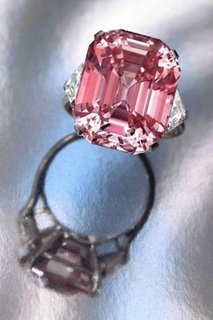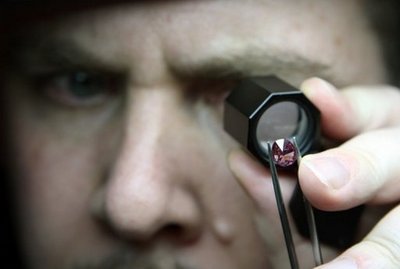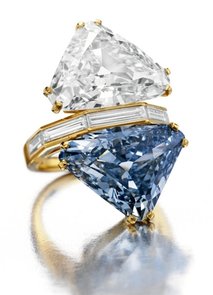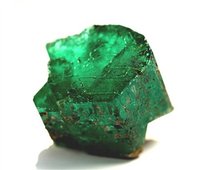 ‘Desirable’ 38M dlr pink diamond up for auction
‘Desirable’ 38M dlr pink diamond up for auction
Auctioneers Sotheby’s said Monday that a rare pink diamond valued at up to 38 million dollars (28 million euros) would go on sale in Geneva next month, dubbing it one of the “world’s most desirable stones.”
The 24.78 carat Fancy Intense Pink Diamond mounted on a ring comes from a private collection, the auction house said.
The gemstone, rated among a type that accounts for just two percent of diamonds, was last seen on the market about 60 years ago when it was sold by legendary US jeweler Harry Winston.
“During my 35-year career at Sotheby?s I have had the opportunity to examine many magnificent and rare gemstones and, put simply, this stone is one of the most desirable diamonds I have ever seen,” said David Bennett, chairman for Europe and the Middle East at Sotheby?s international jewelery department.
“What makes it so immensely rare is the combination of its exceptional colour and purity with the classic emerald-cut — a style of cutting normally associated with white diamonds,” he added.
Sotheby’s gave a pre-sale estimate of 27 to 38 million dollars for the fancy pink diamond, which will go under the hammer on November 16.
Blue, pink and green coloured diamonds are currently the most sought-after gemstones in auctions, according to the auction house.

Several elite auctioneers including rivals Christie’s hold glittering jewelery sales every year in the western Swiss city’s luxury hotels during one week in spring and autumn.
Rare vivid blue diamond up for sale at NYC auction

This undated photo provided in New York by Christie's Images LTD.2010, shows a two-stone ring with a 10.95-carat triangular-shaped blue diamond. The ring, designed by the Italian luxury jeweler Bulgari, is expected to bring in excess of $15 million when it's offered for sale Oct. 20, 2010, in New York. The ring is paired with a 9.87-carat white diamond. … Read more » (AP Photo/Christie's Images LTD.2010) NO SALES
A two-stone ring with a rare triangular blue diamond the size of a quarter on a gold band with baguette-cut diamonds could bring at least $15 million when it is offered at auction in New York next month.
At 10.95 carats, the stone is the largest triangular-shaped fancy vivid blue diamond ever to come to auction, Christie’s told The Associated Press in advance of the Oct. 20 sale. It is paired with a 9.87-carat white diamond cut in the same shape.
“Vivid blue is the strongest and purest saturation in any colored diamond,” said Rahul Kadakia, Christie’s jewelry expert. “As a vivid, this is as good as it gets.”
The two diamonds were cut to be together.
“They are perfectly matched in size and shape. They may be different in terms of weight, but the measurements are perfect. These two stones are made for each other,” Kadakia said.
The Gemological Institute of America said the blue stone in Christie’s sale is the largest triangular-shaped fancy vivid blue diamond they’ve ever graded, Kadakia said.
It is being sold by an anonymous European businessman. Kadakia described him as “someone with a very, very keen eye” who purchased the ring for $1 million from Italian luxury jeweler Bulgari in Rome in 1972 — a gift to his wife for the birth of their son. The couple went on to have three more children, celebrating each birth with an important gift.
Bulgari’s distinctive geometric forms, classic Greek and Roman influences and unusual combinations of colored and colorless diamonds have long adorned celebrities and movie stars, including Grace Kelly, Audrey Hepburn and Elizabeth Taylor.
Last year, a 7.03-carat cushion-cut blue diamond sold at Sotheby’s for $9.5 million, or $1.3 million per carat — setting the highest price ever for a fancy vivid blue gem.
Based on that sale, the Bulgari blue diamond alone is worth $15 million, said Kadakia. With the white diamond, the ring could well surpass that estimate.
The Wittelsbach-Graff Diamond, a 17th-century fancy deep grayish-blue 35.56-carat gem, holds the world record for any diamond and jewel sold at auction. Christie’s sold it in 2008 for $24.3 million.
Worldwide, Kadakia said, blue diamond production accounts for 0.0001 percent of all diamonds produced. And only one in 10 million diamonds have a color pure enough to qualify as fancy vivid blue and measuring over 10 carats.
The blue is determined by trace amounts of boron. The GIA scale runs from faint blue, light blue, fancy light blue, fancy blue, fancy intense blue, deep blue and — when the tonality and saturation are perfect — fancy vivid blue.
The Bulgari blue diamond probably came from the Premier Diamond Mine in South Africa, virtually the only mine in the world producing blue diamonds, Kadakia said. It is where the 3,100-carat rough Cullinan Diamond was found in 1905, and from which the British Crown Jewels the Great Star of Africa and Cullinan II diamonds were cut and polished.
Kadakia estimated that the Bulgari blue diamond came from a rough of at least 20 carats — the rest being lost to polishing.
The world’s largest known deep blue diamond is the 45.52-carat Hope Diamond, discovered in the 1600s, and housed at the Smithsonian.
Kadakia said that in the last 2 1/2 years he has seen a 15-20 percent rise in the number of clients investing in high-end jewelry and diamonds, both those who buy at auction and privately.
“In what other form could you carry $15 million to $20 million so easily?” he asked.
The ring will be officially unveiled at Christie’s Geneva gallery on Tuesday, with stops later in Hong Kong and London before returning to New York.
NC farm produces emerald shaped into massive gem

This undated handout photo provided by gemologist C.R. "Cap" Beesley shows the Carolina Emperor emerald mined by Terry Ledford and Renn Adams in Hiddenite, N.C., prior to any cutting. Gem experts say the emerald yielded at a North Carolina farm may be the biggest ever uncovered in North America. The 65-carat emerald nicknamed the Carolina Emperor was pulled from a farm in the rural community of Hiddenite, about 50 miles (80 kilometers) northwest of Charlotte.(AP Photo/C.R. "Cap" Beesley) ** NO SALES ** (AP Photo/C.R. "Cap" Beesley) NO SALES
An emerald so large it’s being compared with the crown jewels of Russian empress Catherine the Great was pulled from a pit near corn rows at a North Carolina farm.
The nearly 65-carat emerald its finders are marketing by the name Carolina Emperor was pulled from a farm once so well known among treasure hunters that the owners charged $3 a day to shovel for small samples of the green stones. After the gem was cut and re-cut, the finished product was about one-fifth the weight of the original find, making it slightly larger than a U.S. quarter and about as heavy as a AA battery.
The emerald compares in size and quality to one surrounded by diamonds in a brooch once owned by Catherine the Great, who was empress in the 18th century, that Christie’s auction house in New York sold in April for $1.65 million, said C.R. “Cap” Beesley, a New York gemologist who examined the stone.
While big, uncut crystals and even notable gem-quality emeralds have come from the community 50 miles northwest of Charlotte called Hiddenite, there has never been one so big it’s worthy of an imperial treasury, Beesley said.
“It is the largest cut emerald ever to be found in North America,” Beesley said in a telephone interview from Myanmar, an Asian country rich in precious gems.
The discovery is a rarity for emeralds found not in the rich veins of South America and Asia but in North America, said Robert Simon, owner of Windsor Jewelers in Winston-Salem.
“Most of the stones that have come out have not been gem-quality that I would mount in jewelry,” said Simon, who was part owner of a 7.85-carat, dime-sized emerald found in the same community in 1998 that has since been set in jewelry and sold to a private owner.
Terry Ledford, 53, found the roughly 2-inch-square chunk rimmed with spots of iron a year ago on a 200-acre farm owned by business partner Renn Adams, 90, and his siblings. The rural community of Hiddenite is named for a paler stone that resembles emerald.
“It was so dark in color that holding it up to the sun you couldn’t even get the light to come through it,” a quality that ensured an intense green hue once the stone was cut with facets that allowed light into the gem’s core, Ledford said.
The North Carolina stone was cut to imitate the royal emerald, Ledford said. A museum and some private collectors interested in buying the emerald have been in contact, Ledford said.
Modeling an empress’s emerald is likely to have less influence on the North Carolina stone’s sale price than its clarity, color and cut, said Douglas Hucker, CEO of the American Gem Trade Association, a Dallas, Texas-based trade association for dealers in colored gems.
“A 65-carat cut emerald from North Carolina is a big, big stone,” he said. But “once an emerald is cut, it’s subject to the same type of market conditions that any emerald would be.”
Emeralds are part of North Carolina’s mineral claim to fame, though other places in the U.S. also are rich in gems. Maine mines have yielded aquamarine and amethyst, Montana bears sapphires, Idaho is known for star garnets, and Arkansas has diamonds.
It’s not fully known why small, subterranean cavities containing emeralds formed in central North Carolina, said geologist Michael Wise of the Smithsonian’s National Museum of Natural History, who has studied the underground world around Hiddenite for years.
Emeralds are produced where a superheated fluid carrying the element beryllium migrated through rocks that contain chromium, Wise said.
“This doesn’t happen frequently,” Wise said. “The conditions have to be just right to make an emerald. … It happens to be the case at this particular place.”
Adams said decades ago when his parents owned the farm, they allowed anyone with a shovel to dig for emeralds on the property for $3 a day. Virtually all of it was too full of flaws to be cut into precious stones and was mostly sold to mineral collectors, Adams said.
Ledford said they don’t plan to quit after pocketing the profits from their big find, Ledford said.
“We’ll definitely keep on mining,” he said. “It would be good to know you don’t have to go and could do it for pleasure. You feel like you’ve got to find something to survive but since we found this emerald, once we get it sold, there will be less stress.”
Did you know that if you subscribe to our website, you will receive email notifications whenever content changes or new content is added.
1. Enter your e-mail address below and click the Sign Me Up button.
2. You will receive an email asking you to confirm your intention of subscribing to our site.
3. Click the link in the email to confirm. That’s all there is to it! Note: if you wish to unsubscribe from our site, click the unsubscribe link at the bottom of the email you received.
Then indicate you no longer wish to receive our emails.
Thank You
Prisonbreakfreak.com Team